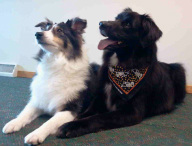|
If you've read any of my previous blogs, specifically the letter I wrote to Rico Suavé, you may get the sense that not only is he my baby dog, he is my dog that requires behavior adjustment! What this means is that he has behavioral issues, mainly reactivity associated with fear of strange dogs and sometimes people. Because I've known (although not "owned") him since he was 6 weeks old, I've always seen a shy fearful dog in him. If only I knew then what I know now, I would have made a much stronger effort to socialize him to the world. Regardless of his past, I fall into a category that many dog parents do. We have dogs that:
-are unreliable or unpredictable in others' care, -can't be off leash around strangers as they may lunge or flee, -barky dogs that we are embarrassed to take into public areas, -and the list goes on. You may fall into this group of doggie parents if you had a shy dog who was under-socialized as a puppy such as Rico but you may also have inherited or adopted a dog from a shelter that came home with reactivity issues. Regardless, we can't change the past and instead can only look forward to a brighter future. Every time I meet a reactive dog my heart melts for them. When I first meet these dogs, they may bark or growl at me, run away or sit shivering in fear, but I immediately love each and everyone of them. If you take a moment to look past the symptoms, dogs that are categorized as reactive are some of the sweetest and most loving dogs of all. They are committed to their family, and work well with praise and attention as rewards. These dogs truly want to please, but for whatever reason they see the rest of the world as a massive threat. In my Taco's case, once he gets to know someone well, and feels he can trust said person, they become great friends. He will whine and get excited if you mention that persons name, (i.e. "Grandma" is his favorite person to visit). He used to be so scared of my niece and nephew but now he is excited when they come to visit and he could play and cuddle with them all day! His favorite strangers are the ones that want nothing to do with him and that's because they don't approach him (he loves to sneak sniffs when no one is looking though). I am this dog's mommy! He loves to cuddle with me (as long as his "scary" sister isn't around to sneak attack him, -she never does but he has an irrational fear that she is out to get him) he loves to play ball with me, but ultimately he is just happy as long as we are in the same room together. This puppy has followed me around -like a lost puppy- ever since I decided to make him mine. This bond is extremely common in reactive dogs. I have yet to meet a pup-parent that doesn't love their nervous dog to pieces. Because these dogs are so fearful of the real world, they look to their family for security, and are often extremely affectionate to the ones that care for them. This obviously makes them very easy to love, but it doesn't mean it's a fun experience. In fact caring for a reactive dog can often be very frustrating. You want to trust them and give them chances to grow and change but if they mess up it can have very serious consequences (i.e. injury to your own dog, other dogs, other people, potential euthanasia :0( ), and this then turns us into fearful owners. Being an anxious owner of a fear reactive dog turns into disaster when our emotions rub off on a dog that we are trying to teach to relax. Scientific studies have concluded that dogs can sense fear in humans, unfortunately the reason they sense it from us is not yet determined. This means we can't fake feeling secure in ourselves, our dogs will know. It will take training our inner selves to relax when our dog may begin acting reactive, and not having a negative reaction that will only worsen our dogs' current state of mind. Like I said I love these dogs to pieces! I love the parents who love their reactive dogs! Because of this I am working on developing a growly dog class for the new year. This may seem like a long way off but it's coming fast. This class will be low-cost to cover supplies and encourage people to join. However because of the low cost I will be accepting participants via an application process and first come, first serve basis. I will update with more info ASAP but don't hesitate to get your foot in first! Thank you all for loving dogs as much as I do and I look forward to hearing from you all soon!
3 Comments
|
Author
Archives
July 2023
Categories
All
|


 RSS Feed
RSS Feed
